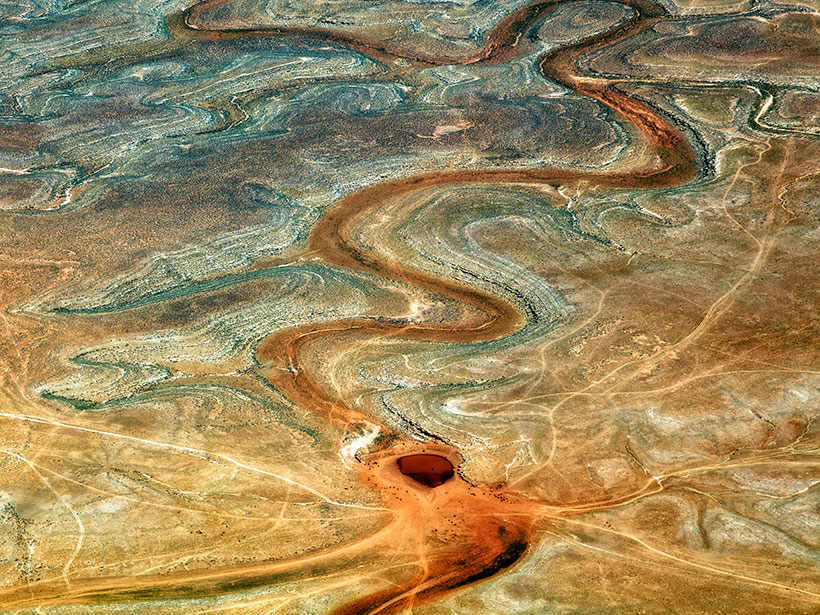Dry seasons, abnormally low snowpacks, and even intentionally lowering reservoir levels can dry up inland waters. Increasing temperatures and human demands for water can make these periodic drying events more common.
In the past, dry inland water systems were a murky landscape to researchers. But on a recent field study, scientists happened to measure carbon emissions from one of these dry riverbeds. They found elevated carbon dioxide (CO2) emissions from the sediments and wondered whether their findings were unique to that area or ubiquitous in all dry inland waters.
With an international consortium of researchers, the team tested almost 200 dry inland waters around the globe. They found that in all climate zones and ecosystems, the CO2 emissions are significant in dry systems. They said their results are important in understanding the global carbon cycle in a warming and human-influenced landscape.
An Unexpected Discovery
While out on a field campaign in Spain, a team of researchers were measuring carbon emissions in a river catchment in Catalonia. On a whim, they veered into the dried riverbed to take a few measurements.
“Surprisingly, we observed quite high CO2 emissions from this very dry gravel bed,” said Matthias Koschorreck, a biogeochemist at the Helmholtz Centre for Environmental Research in Magdeburg, Germany, and a coauthor of the study in Nature Communications.
Their localized discovery kick-started an international collaboration.
“The question was whether the process is relevant on a global scale or not,” said Koschorreck. “And whether it’s occurring in all kinds of dry freshwater systems or only in streams.”
An international network set out to sample in multiple locations and climates. “In the end, it’s more than 25 teams around the world,” he noted, adding that they sampled more than 200 sites in 196 different dry inland waters within diverse ecosystems and climates.
“We activated a network and found enough enthusiastic scientists to work together on a common research question. That was a supernice experience—it’s a very good way to do science.”
“We activated a network and found enough enthusiastic scientists to work together on a common research question,” said Koschorreck. “That was a supernice experience—it’s a very good way to do science.”
Global Dry Waters Emissions
The team members collected data from Greenland to southern Australia. Along with CO2 emissions, they measured temperature, sediment moisture, and organic matter content for each site.
They made a surprising discovery: High carbon emissions from dry inland waters were a global phenomenon, independent of location, climate zone, or type of inland water.
Koschorreck explained that the interplay between temperature, moisture, and organic content was the driving factor with carbon emissions. Colder temperatures and drier conditions mean lower emissions, explained Koschorreck, whereas warm temperatures and wetter climates can boost CO2 emissions. That difference meant that Greenland, where the conditions are cold and wet, had emissions similar to those of the warm, but dry, western United States.
Current estimates of carbon emissions from surface waters are 2.1 petagrams per year. If dry sediment contributions were included, Koschorreck said, “this number would increase by 6%,” or an additional approximately 0.12 petagram of carbon per year.
Categorizing an In-Between System
Categorizing landscapes that fall somewhere on the terrestrial-aquatic spectrum is a long-standing issue among environmental scientists.
If the contribution of intermittently dry inland waters is so significant, why have measurements of these ecosystems been largely ignored in carbon cycle research? Koschorreck said dry inland waters are “kind of an in-between system between the terrestrial scientific community and the aquatic one,” and categorizing landscapes that fall somewhere on the terrestrial-aquatic spectrum is a long-standing issue among environmental scientists.
David Butman, a biogeochemist at the University of Washington who was not involved with the new research, said a study like this one is an opportunity to explore what’s happening at this very dynamic interface between terrestrial ecologists and limnologists. “Not a lot of attention has been given there, so from a primary science standpoint, this is a pretty cool contribution,” he said.
Future Carbon Estimates
Koschorreck said the team’s work will be included in the next report from the Intergovernmental Panel on Climate Change and is also important for those interested in the environmental effects of reservoirs. “Hydropower is considered clean energy, but in recent years it turns out that there [are] also some drawbacks,” he explained. “The question is whether water fluctuations, which create dry sediments, can change the greenhouse gas emissions from reservoirs.”
Butman agreed, noting that in a time when people are starting to think about removing dams, carbon flux calculations haven’t been considered.
“What you’re doing [with dam removal] is…taking previously inundated land and completely exposing it,” said Butman. He notes that years of sediment buildup in a reservoir have the potential for being a large carbon storage system. Exposing this sediment to air could quickly change the area’s carbon flux.
Butman noted that getting emission measurements from dry reservoirs “could be really interesting” for understanding the carbon space. “This idea of anthropogenic disturbance—removing water from flowing systems and exposing more of the sediment to decomposition and respiration—is really fascinating from a carbon cycle perspective,” said Butman.
—Sarah Derouin (@Sarah_Derouin), Science Writer
Citation:
Derouin, S. (2020), Frequently dry waterways still contribute to carbon emissions, Eos, 101, https://doi.org/10.1029/2020EO145213. Published on 11 June 2020.
Text © 2020. The authors. CC BY-NC-ND 3.0
Except where otherwise noted, images are subject to copyright. Any reuse without express permission from the copyright owner is prohibited.

